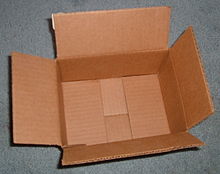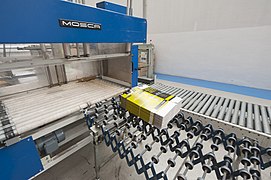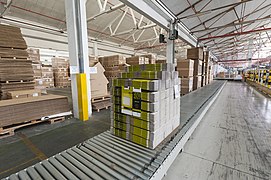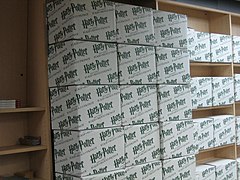Flap box
Also colloquially called American box, the box with flaps is a package with four lateral faces (mathematically, a prism with a rectangular base) that closes both on the inside upper and lower by means of four flaps. Its FEFCO code is 0201.
Generally made of cardboard made from oak wood, its great versatility and ease of production with flexible machines without dies called casemakers have made it very popular.
Structure
Structurally, the flap box is a closed ring covered by four flaps extracted from the structure itself. The flaps usually have a uniform height to optimize the ironing surface. The long ones are folded together in the center of the box and the short ones are recessed below them. Its height is therefore equivalent to half the width of the packaging.
The wave is placed vertically to give the packaging maximum resistance. Therefore, it is usually located perpendicular to the ring, except in cases where the box travels lying down, when it is designed in the opposite direction.
Manufacturing process
The first operation consists of inserting into the cardboard sheet the slits through which the upper and lower flaps will be folded. This is done in the manufacturing process of the plate in the corrugator by means of the circular die called slitter.
Then, as in the rest of the cardboard packaging, the manufacture of the box begins with the decoration of the plate that is done in a printer. Flexographic printing uses polymer clichés to deposit the ink on the support, requiring as many clichés as colors in the box. In general, the printer is placed in line with the casemaker, which is the machine that will give the box its final structure. The following operations are performed on this machine:
- slotted to form the flaps
- in the wave direction
- folded box
- pasted from the binding tab
In this way, the box is ready for subsequent packaging. Finally, the palletizing and strapping operations take place. The box is delivered, therefore, to the packer, printed, folded, glued and palletized.
Packaged in folding box
The flap box is a versatile packaging that is used in both manual and automatic packaging lines.
In the first case, the process is as follows. The lower flaps are closed with a seal. Next, the product is introduced and conditioned manually. Then, the upper flaps are closed with another seal.
In the second case, the process is carried out through packaging machines that are installed at the end of the packaging line. There are various boxing systems for American boxes but the basic procedure is as follows. Product units are grouped into batches based on the number to be packed. Some suction cups form the box and proceed to the lower closure by means of hot glue (hot melt). Then, the product is introduced into it. At this point there are two ways:
- Vertical lace. The products are introduced at the top of the packaging. It is common in products that are manipulated through picking like bottles, jars, rigid packages, etc. Some products are introduced at the bottom by lowering the box on them but it is a more unusual process.
- Horizontal lace. The folded box moves horizontally to a point where it opens laterally through suction cups. The product once grouped is pushed inside.
Lastly, the upper flaps are closed using hot glue or hot melt.
Gallery
Contenido relacionado
German mark
Weight (currency)
Annex: Billionaires according to Forbes








